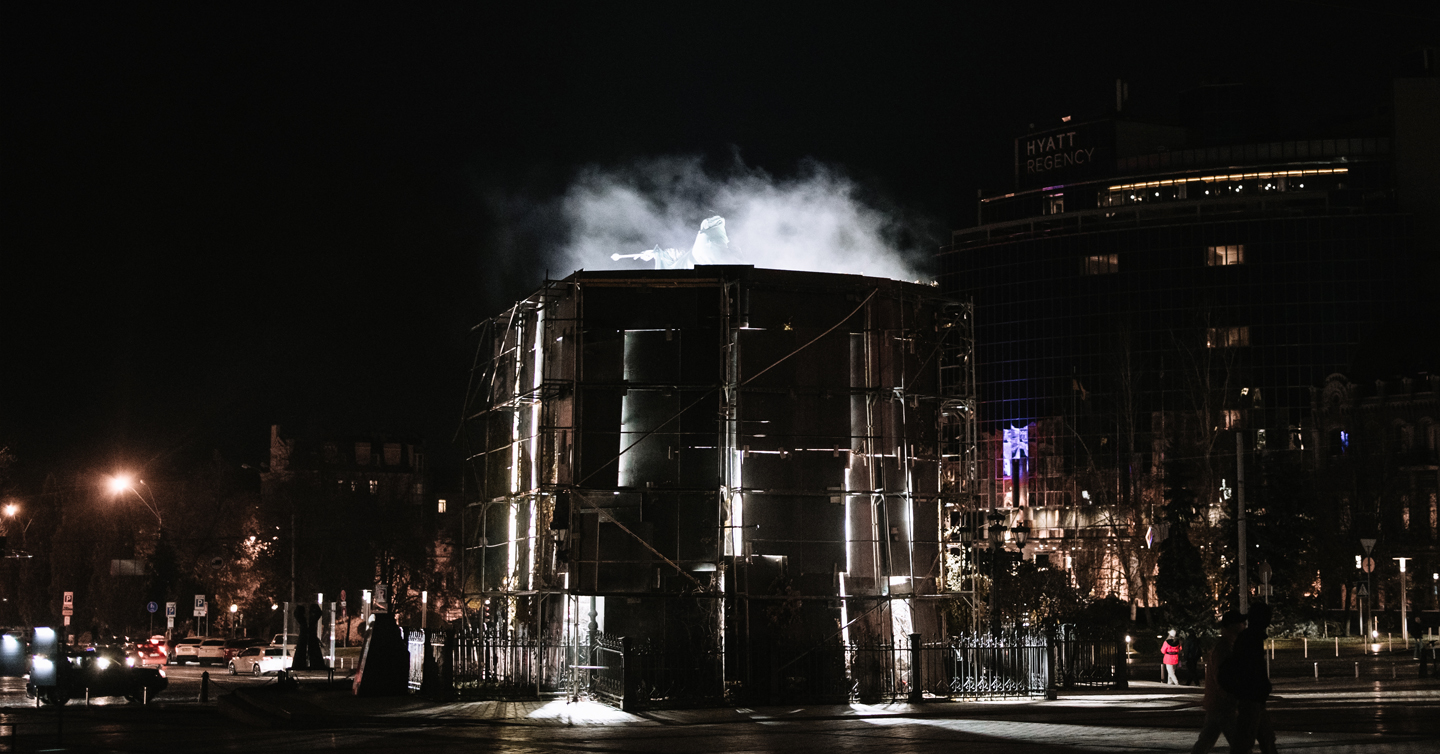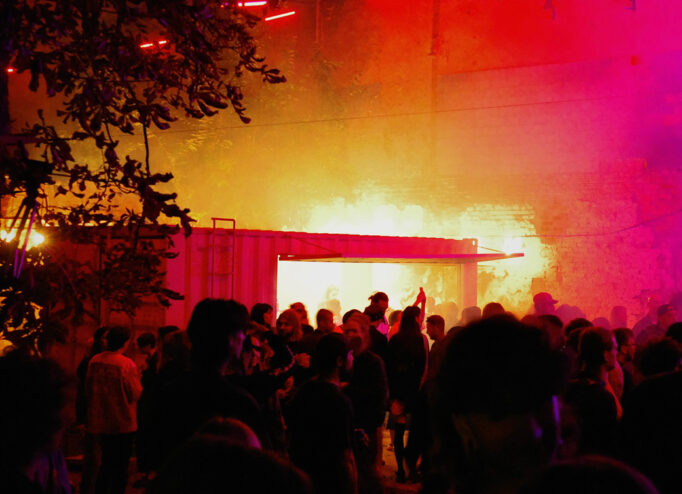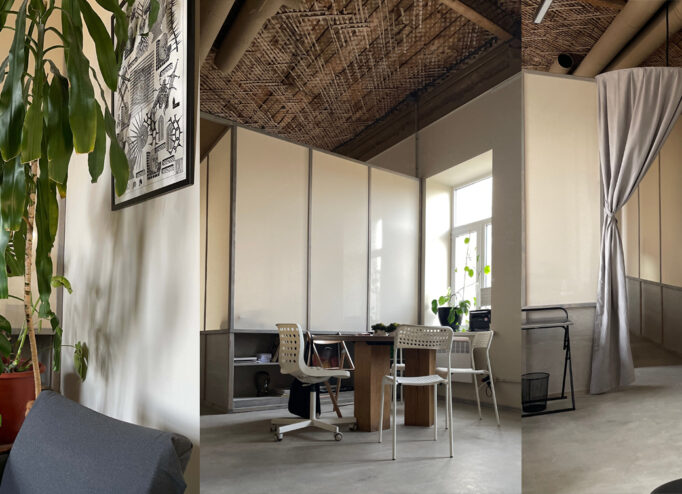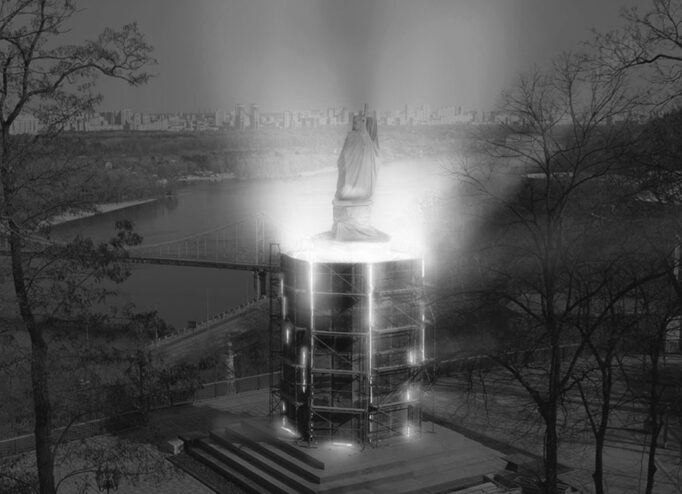Pablo Valbuena’s art projects are a kind of contemporary rituals. Working with light, sound and different scales of space, he explores questions of time, perception and context. And Kyiv was no exception: for three consecutive evenings, three iconic monuments were transformed into installations where pulsating light and white smoke ‘merged’ with the voices of Ukrainian poets who read their own poems.
DTF Magazine talked to Pablo about what he realized when he first came to Kyiv, how the idea of the project changed and why it is important for him to place Ukrainian poetry in public space, connecting it with monuments.
This interview is released with the support of one of the largest European crypto exchanges with Ukrainian roots — WhiteBIT, which together with MOT and don’t Take Fake implemented ‘Spectral Poetry’
‘Spectral Poetry. [Kyiv]’
The pedestals and structures that hide and at the same time protect Kyiv’s monuments to Volodymyr the Great, Hryhorii Skovoroda and Bohdan Khmelnytsky from the effects of russian shelling are transformed into installations. From inside, they are illuminated by special devices that create pulsating visual effects to the sounds of poetry recited by 11 Ukrainian poets.
‘Created in public spaces and in full view of the public, this project between light and shadow, past and future, will take place among historical monuments now hidden beneath protective layers, — Fabrice Bousteau, curator of the exhibition at MOT, writes. — For a few hours, the artist will re-enchant this silenced cultural heritage with a flow of light pulses synchronized to the rhythm of the words and voices of Ukrainian poets. Radiant in the heart of Kyiv, ‘Spectral Poetry’ sensitively extends MOT’s ambition: to illuminate thought in the here and now through artistic creation’
Learn more
— As far as we know, the primary concept of the project envisioned other locations — and these were locations that had been destroyed by the russian army. Like, for example, houses destroyed by missiles or cars that were shot up. But after you came to Kyiv to attend the opening of MOT you changed the idea a little bit. And you chose other locations. Why did these changes take place? What did you see and understand when you visited Ukraine?
— One of the key elements of my projects is investing time and energy required to understand the context where they take place. In this case it is even more important because the implications are serious, the Ukrainian people are suffering and such a struggle cannot be taken lightly.
In my first visit to Kyiv in February 2023 I realized some things. One is that the day to day experience in a country at war is completely different than what we perceive in the media.
In the media they are focused on destruction, there is no news if there is no drama and shock. Most media are not interested in complexity or subtlety, they are rarely focused on reconstruction and healing, they rather look for short-term attention and clicks.
The daily life in Ukraine on the contrary is centered on resistance and survival, physical but also mental and emotional. It is aimed much more towards positive elements: endurance, healing and a sense of community.
The most remarkable aspects of my first visit to Ukraine were fundamentally related to endurance, hope and healing: witnessing the reconstruction of many areas that were destroyed just a few months before and experiencing how everyone is invested in helping others, in functioning as a generous community.
These aspects shifted considerably the project, it became clear that my work should be only a catalyst to project the voices of Ukrainians that are living, experiencing first hand these times, in this case Ukrainian poets.
— Your first version of the project somehow emphasized the destruction suffered by Ukraine. But the idea about monuments is more about defense and resistance. What do you think Ukraine needs to broadcast to the world now — the destruction or to show that life and struggle continue here despite the war?
— War brings mostly terrible things but at the same time the social values, strength and generosity that Ukrainian society is experiencing are remarkable. War brings to the surface the worst and the best humans are capable of.
A lot of these values that you experience in Ukraine are difficult to see elsewhere, where many people are focused on economical aspects and very self-centered. Ukrainian society has a lot of positive things to be an example of in these difficult times, other countries and their media should be looking with a different prism, we might learn something.
Another aspect is the role of culture in all this. Russian aggression is not only a physical warfare but it’s a cultural war. They are targeting language, heritage and social values, a culture that they cannot control and that can somehow bring out their own internal problems, and they are very afraid of that.
— By the way, you quote Serhiy Zhadan in the description of your work. How did you find out about him?
— I learnt about his work when I was doing this project, then I had the chance to listen and briefly meet him at an event about Ukrainian culture in Paris at the end of 2022. He is a very interesting writer and thinker in Ukraine with an understanding on what’s going on and the first hand experience of living through a war in Kharkiv, and he is very engaged in supporting the Ukrainian cause and army. He has important views on the role of culture at times of war. Ukrainian culture is a form of resistance and a way to build a future after the war.

‘Spectral Poetry’, Monument to Bohdan Khmelnytsky (Sofia Square). Photo: Viktor Rasputin, specially for don’t Take Fake & MOT
— If we talk about technical and visual components, what was important for you to show and do? What did you want to emphasize?
— I always start with an idea rooted in context. Then I look for tools, technical resources and visual elements to represent it and I discard everything that is non fundamental, I aim to present that idea in the most direct and simple way. I create experiences with several levels of depth but that are accessible to anyone willing to pay attention.
My intention is that the project can be read through several layers, depending on who is observing and their background, like an onion that you peel layer by layer.
The main idea of ‘Spectral Poetry’ is to interlace the public memorials of the past in the city of Kyiv, protected from war, with the voices of Ukrainian poets assimilating the present and projecting the future with their work.
— You worked with Ukrainian-language poems by poets, which you combined into a coherent artistic work. Can you tell us how you worked with the texts?
— Ostap Slyvynsky helped me a lot, he is very familiar with the Ukrainian cultural scene and the project would not have been possible without his help. The most important element of ‘Spectral Poetry’ was the contribution of the poets themselves, with an extraordinary wide range of their poems.
The project is based on the readings of the poems by the poets themselves, what you hear in the installations are their voices performing their work. I was able to follow their poems thanks to the written transcriptions and translation tools. They had complete freedom to choose their poems, trying to focus on the present times.

‘Spectral Poetry’, Monument to Volodymyr the Great (‘Saint Volodymyr Hill’ Park). Photo: Viktor Rasputin, specially for don’t Take Fake & MOT
— There were no strict restrictions on the subject matter for the participating poets — it was more of a general theme, ‘how do you feel during this period’. Tell us, which topics did poets choose and what do they talk about in your project?
— There are extraordinary poems in the selection. With eleven poets, eight women and three men, there is a very wide range of understanding and ways of processing present times, from very tender poems about hope, children and love, to the darker places inevitably linked to wartime. What I noticed and very much appreciated, is that even in the darkest poems, you can almost always find something positive, a thin streak of optimism, humor, resilience, endurance and hope.

‘Spectral Poetry’, Monument to Hryhorii Skovoroda (Kontraktova Square). Photo: Viktor Rasputin, specially for don’t Take Fake & MOT
— It is often written that your ‘art explores the intersection of the real and the virtual’. But how do you define ‘actual/real’ and ‘virtual’?
— In my works, I try to bring the potential of virtuality back to reality. I believe that virtuality, and the informational layer of reality in general, has great potential. But it doesn’t mean anything to us if we can’t experience it profoundly and be touched by it. It’s extremely difficult to have a life-changing experience through a screen. We are fundamentally embodied creatures in a certain place and time, and we need physical reality and the sense of sharing with others to create meaningful memories of our experience.
In this installation for instance, the core is listening to poetry in a shared setting with a certain cultural and social meaning. The virtual layer, the digitally synchronized light and recorded voices of the poets, only makes sense when it takes place in a shared public place, a memorial protected from war. The virtual layer becomes a fully embodied experience. It’s a shared contemporary ritual in physical space and time.

Pablo Valbuena
— As a person, who used to work and still works with virtual things, what do you think about artificial intellect? Could it pose any danger to artists?
— Regarding AI, it is an interesting tool, it can accelerate tasks and complement information, the main impact is in quantitative terms. But artificial intelligence cannot substitute a deep, complex and subtle creative process. AI lacks the most important aspect of human creativity: the intention and internal need to express something.
— Why did you choose sound and light as your main artistic tools?
— Because they are the most useful ‘materials’ to build, transform and sculpt time. These mediums have a different temporality than traditional art mediums, such as paint, stone, wood or metal. They have their own different sets of challenges.
— When you are working on a new project — how do you usually begin? What things must be done firstly?
— Context is fundamental, every new project starts with a research of the place and its surroundings. A site visit is one of the first important steps.
— One of your recent works, ‘Aura’ was made in St. Paul’s Cathedral. Are there any limits for you when you are choosing or being offered a new place to create a project? In your opinion, should there be any specific code of ethics for an artist?
— Of course this should be in any contexts, including those that are widely accepted as normal in an artistic environment. Art has a social function and as artists we have to be attentive to what the final social, political or economic impact of our work will be. Artworks have a life on their own and it is difficult to control once an artwork is out of the artist’s hands, but how and why an artwork is created has a definitive weight on how the public understands and experiences it and makes it their own.


‘Spectral Poetry’, Monument to Bohdan Khmelnytsky (Sofia Square). Photo: Viktor Rasputin, specially for don’t Take Fake & MOT
— Do you have any goals as an artist? Should art have a high or noble role and inspire or heal people or evoke some thoughts? Or is it enough for it to be something meaningless but beautiful, something that people can just like and that’s it?
— Art has a social function similar to that of science, philosophy or research, it can also have similar aspects such as activism or spiritual beliefs, sometimes several of them combined.
Art is an overused term, we hear many things described as art that probably shouldn’t. Art is more than something beautiful, entertaining or pleasing. There’s a line between entertainment and culture, the first is there to entertain, amuse, please and distract. Culture and art is there to engage, heal, educate, spark and challenge, hopefully to contribute to form critically discerning people.







